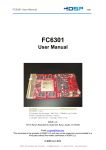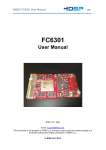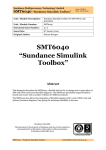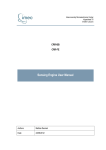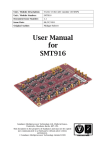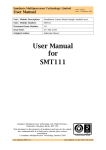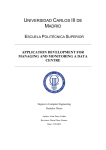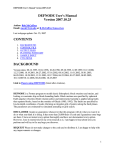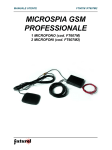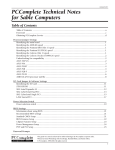Download SMT911 User Manual - Sundance Multiprocessor Technology Ltd.
Transcript
Form : QCF42 Date : 11 February 2009 Describes the demo and SMT911 operation. SMT911 1.0 15 Jan. 10 C. H. Gray Sundance Multiprocessor Technology Ltd, Chiltern House, Waterside, Chesham, Bucks. HP5 1PS. This document is the property of Sundance and may not be copied nor communicated to a third party without prior written permission. © Sundance Multiprocessor Technology Limited 2009 SMT911 User Manual SMT911 Last Edited: 01/06/2010 10:09:00 1.0 Initial Release SMT911 User Manual SMT911 15 Jan. 10 Page 2 of 38 CHG Last Edited: 01/06/2010 10:09:00 1.1 Referenced Documents .............................................................................................. 7 2.1 Acronyms and Abbreviations ................................................................................... 8 3.1 Interface Description................................................................................................ 10 3.1.1 Electrical Description .......................................................................................... 10 3.2 Block Diagram............................................................................................................ 10 3.3 Module Description .................................................................................................. 11 3.3.1 Clock Distribution ................................................................................................ 11 3.3.2 JTAG........................................................................................................................ 11 3.3.3 Antenna Connectors ............................................................................................ 12 4.1 Functional Overview ................................................................................................. 13 4.2 Control Registers ...................................................................................................... 14 4.2.1 Control Packet Structure .................................................................................... 14 4.2.2 Reading and Writing Registers .......................................................................... 14 4.2.3 Register Map.......................................................................................................... 15 4.3 Running Demo ........................................................................................................... 16 4.3.1 Transmitter ........................................................................................................... 17 4.3.2 Receiver .................................................................................................................. 17 5.1 Top View ..................................................................................................................... 19 5.2 Bottom View ............................................................................................................... 20 6.1 SLB Interface .............................................................................................................. 21 10.1 2.4GHz Frequency Plan and Divider Ratio Programming Words .................... 25 10.2 5GHz Frequency Plan and Divider Ratio Programming Words ........................ 25 10.3 Reset Register 0x00 .................................................................................................. 26 SMT911 User Manual SMT911 Page 3 of 38 Last Edited: 01/06/2010 10:09:00 10.4 Test Register 0x01 .................................................................................................... 26 10.5 Function Register 0 – 0x02...................................................................................... 26 10.6 Function Register 1 – 0x03...................................................................................... 26 10.7 Function Register 2 – 0x04...................................................................................... 27 10.8 MAXIM A Register 0 – 0x05 (Standby)................................................................... 27 10.9 MAXIM A Register 1 – 0x06 (Integer-Divider Ration) ......................................... 28 10.10 MAXIM A Register 2 – 0x07 (Fractional-Divider Ratio) ...................................... 28 10.11 MAXIM A Register 3 – 0x08 (Band Select and PLL) ............................................. 28 10.12 MAXIM A Register 4 – 0x09 (Calibration) ............................................................. 29 10.13 MAXIM A Register 5 – 0x0A (Low-pass Filter) ..................................................... 29 10.14 MAXIM A Register 6 – 0x0B (RX Control/RSSI).................................................... 30 10.15 MAXIM A Register 7 – 0x0C (TX Linearity/Gain) ................................................. 30 10.16 MAXIM A Register 8 – 0x0D (RX Gain) .................................................................. 30 10.17 MAXIM A Register 9 – 0x0E (TX VGA Gain) .......................................................... 31 10.18 MAXIM B Register 0 – 0x0F (Standby) ................................................................... 31 10.19 MAXIM B Register 1 – 0x10 (Integer-Divider Ratio) ............................................ 31 10.20 MAXIM B Register 2 – 0x11 (Fractional-Divider Ratio) ....................................... 31 10.21 MAXIM B Register 3 – 0x12 (Band Select and PLL).............................................. 31 10.22 MAXIM B Register 4 – 0x13 (Calibration).............................................................. 31 10.23 MAXIM B Register 5 – 0x14 (Low-pass Filter) ...................................................... 31 10.24 MAXIM B Register 6 – 0x15 (RX Control/RSSI) .................................................... 31 10.25 MAXIM B Register 7 – 0x16 (TX Linearity/Gain) ................................................. 31 10.26 MAXIM B Register 8 – 0x17 (RX Gain) ................................................................... 31 10.27 MAXIM B Register 9 – 0x18 (TX VGA Gain) .......................................................... 32 10.28 ADDAC A Register 0 – 0x19 .................................................................................... 32 10.29 ADDAC A Register 1 – 0x1A ................................................................................... 32 10.30 ADDAC A Register 2 – 0x1B .................................................................................... 32 10.31 ADDAC A Register 3 – 0x1C ................................................................................... 33 10.32 ADDAC A Register 4 – 0x1D ................................................................................... 33 10.33 ADDAC A Register 5 – 0x1E .................................................................................... 33 10.34 ADDAC A Register 6 – 0x1F .................................................................................... 34 10.35 ADDAC A Register 7 – 0x20 .................................................................................... 34 10.36 ADDAC A Register 8 – 0x21 .................................................................................... 34 10.37 ADDAC A Register 9 – 0x22 .................................................................................... 35 10.38 ADDAC A Register 10 – 0x23 ................................................................................. 35 10.39 ADDAC A Register 11 – 0x24 ................................................................................. 36 10.40 ADDAC B Register 0 – 0x25 .................................................................................... 36 SMT911 User Manual SMT911 Page 4 of 38 Last Edited: 01/06/2010 10:09:00 10.41 ADDAC B Register 1 – 0x26 .................................................................................... 36 10.42 ADDAC B Register 2 – 0x27 .................................................................................... 36 10.43 ADDAC B Register 3 – 0x28 .................................................................................... 36 10.44 ADDAC B Register 4 – 0x29 .................................................................................... 36 10.45 ADDAC B Register 5 – 0x2A .................................................................................... 36 10.46 ADDAC B Register 6 – 0x2B .................................................................................... 36 10.47 ADDAC B Register 7 – 0x2C .................................................................................... 36 10.48 ADDAC B Register 8 – 0x2D.................................................................................... 36 10.49 ADDAC B Register 9 – 0x2E .................................................................................... 37 10.50 ADDAC B Register 10 – 0x2F .................................................................................. 37 10.51 ADDAC B Register 11 – 0x30 .................................................................................. 37 10.52 Update Register 0x31 ............................................................................................... 37 10.53 Update RSSI Register 0x32 ...................................................................................... 37 10.54 RSSI Register A 0x33 ................................................................................................ 37 10.55 RSSI Register B 0x34 ................................................................................................. 38 SMT911 User Manual SMT911 Page 5 of 38 Last Edited: 01/06/2010 10:09:00 The SMT911 is an advanced, high-quality MIMO transceiver card, designed to cover all features of future high-speed MIMO radio systems. The SMT911 comprises two complete, fully configurable transceiver chains between two dual 12-bit digital I/Q interfaces and two dual-band 50 Ohm antenna ports for each channel. Each transceiver chain is comprised of an integrated RF-frontend (band switch, T/R switch and power amplifier), up-/down converters with on chip PLLs and high performance analog-to-digital and digital-to-analog converters for the I/Q signals and additional analog-to-digital converters for RSSI conversion. With a single on-board crystal or externally supplied common reference clock for the transceiver PLL‟s, multiple SMT911 cards are easily combined to build an arbitrary size 2m x 2n MIMO system with coherent LO phase. All control signals, data bits and the SPI bus are routed through a 120-pin QSH data connector providing for flexible, application specific configuration and control during operation. The SMT911 is designed to fit on and connect directly to an FPGA base module like the Sundance SMT351T or SMT368. The provided demo SMT911 Firmware Control Module permits simple and unrestricted access to all control registers from a user friendly C-Language API. SMT911 User Manual SMT911 Page 6 of 38 Last Edited: 01/06/2010 10:09:00 SiGe Se2545A23: Dual Band 802.11 Wireless LAN Front End MAX2828/2829: World-Class Transceiver-IC, MAXIM AD9863: Analog Devices dual ADC/DAC Sundance Local Bus: (SLB) specification ftp2.sundance.com : TIM specification SMT148FX: Carrier with 4 Module sites SMT6048: Host-side USB software interface to Sundance hardware SMT6002: Sundance Flash Programming Utility (FPGA) SMT911 User Manual SMT911 Last Edited: 01/06/2010 10:09:00 A list of acronyms etc: http://www.sundance.com/web/files/static.asp?pagename=acc SMT911 User Manual SMT911 Last Edited: 01/06/2010 10:09:00 The SMT911 is an advanced, high-quality MIMO transceiver card, designed to cover all features of future high-speed MIMO radio systems. It is used in combination with Sundance base modules such as the SMT351T. On the SMT911 transceiver card, two single-chip MIMO RF front-ends (SE2545A23) are applied, containing nearly all circuitry required between the transceiver and the antenna. Two transceiver chips of type MAXIM MAX2829 are used to up and downconvert signals between the WLAN carrier bands and the base-band. The MAX2829 is specially designed for MIMO/Smart Antenna application and the IEEE 802.11a/g standard. In order to fulfill the requirements of more simple and clever MIMO solutions, the SMT911 transceiver card is equipped with two built-in ADC/DAC chips from Analog Devices – AD9863. Each of the transceiver (MAXIM) chips is served by one AD9863. The AD9863 integrates dual 12-bit ADCs and dual 12-bit DACs. The dual DACs convert the digital base band I/Q signals to analog signals when the SMT911 card acts as a transmitter. When the SMT911 card acts as receiver, the dual ADCs convert the analog base-band I/Q signals into a digital format for the FPGA base board. Two additional ADC‟s (AD7476) are provided to enable conversion of the Receive Signal Strength Information (RSSI) from the MAXIM transceivers. All control pins of the mentioned ICs above are routed through to the base module via the QSH connector. The firmware on the base module offers the user flexibility to specify control signals and control register settings. More details about the firmware are explained in the Firmware implementation section. The SMT911 card has two external reference clock inputs. These external clock inputs provide the reference for generating the sampling clock in both ADC/DAC chips, and provide the transceiver PLL‟s a reference for creating the required 2.4GHz or 5GHz carrier frequency. Both of these circuits can be run for wider synchronization from these connectors, or from a fixed, on-board oscillator output of 40MHz. The maximum clocking speed of the internal ADC‟s is 50MHz, and the maximum clocking speed of the internal DAC‟s is 200MHz (attainable through internal PLL multiplying). SMT911 User Manual SMT911 Last Edited: 01/06/2010 10:09:00 • 4 SMA connectors (50 Ohm) for dual-band antennas providing TX/RX • Two MMCX connectors (50 Ohm) external clock input • Samtec BKT connector for 5 V and 3.3 V power supply • 120-pin Samtec QSH connector for all digital I/O signals • JTAG connector for debug/access to FPGA on base-board. • Plugs directly into a wide range Sundance SLB TIMs Each pin on the BKT power connector (33 pins in total) can carry 1.5 A. Digital 5V (D+5V0), digital 3V3 (D+3V3) and digital ground (DGND) are provided over this connector. D+3V3 and D+5V0 are assigned four pins each. The daughter card can thus draw a total of 6A of each of these two supplies. The major elements of the SMT911 are shown in the block diagram below (single channel shown). SMT911 User Manual SMT911 Page 10 of 38 Last Edited: 01/06/2010 10:09:00 There are two MMCX connector clock inputs for the SMT911. Clock A provides a 40MHz clock input for the MAXIM transceiver IC‟s. Clock B is the input for both CLKIN1 and CLKIN 2 of ADC/DAC A and ADC/DAC B. Clock distribution is achieved by two CDCV304 clock buffer drivers. Because the clock inputs to both pins CLKIN1 and CLKIN2 of the ADC/DAC‟s are shared, the clock provided here cannot exceed 50MHz (the maximum speed of the internal ADC‟s) if switching from TX to RX is the ultimate goal. To achieve higher frequencies with the DAC‟s, the ADC/DAC‟s internal PLL circuitry must be implemented to multiply and output the clock onto IFACE2. This is programmable via SPI up to 200MHz. For ease of use, a high quality 40MHz crystal has been placed on the mezzanine to provide clocking for either both MAXIM transceivers, both ADC/DAC‟s, or all four IC‟s. These configurations are selectable via jumpers 1 and 2. Jumper Both use XTAL Both use External XTAL CLKA/External CLKB External CLKA/XTAL CLKB CLKA off on off on CLKB off on on off The clock source is driven by two jumper controlled, multi-function gates that drive two CDCV304 clock buffers. The jumper marked CLKA will select the source clock for the MAXIM chip. With no jumper, the defaulted clock source is the onboard 40MHz crystal. With the jumper, the external CLK6 jack (J6) is then the chosen input for the MAXIM clock. The same arrangement exists for CLKB, the clock source for the ADDAC chips. If the jumper is attached, an external clock source (J3) is expected; otherwise, the crystal will output a 40MHz clock to pins CLKIN1 and CLKIN2 of the ADDAC chips. The external clock jacks are AC coupled and so do not require any DC offset to drive this logic. The clock provided to the MAXIM chip if external must be 40MHz from a quality, stable source. The clock provided to the ADC/DAC chips must be a quality, clean source and not exceed 50MHz if in a switching TX/RX configuration, as this source clock feeds the internal ADC and DAC. A standard Xilinx parallel JTAG header is supplied on the mezzanine to provide access to the base modules JTAG chain. SMT911 User Manual SMT911 Page 11 of 38 Last Edited: 01/06/2010 10:09:00 Four SMA antenna jacks are connected directly to the output of two SiGe RF frontend IC‟s. Each channel shares both band A and band G on the same TX connector, and both bands on the same RX connector. The antennas should be connected as described below. SMT911 User Manual SMT911 Page 12 of 38 Last Edited: 01/06/2010 10:09:00 The demo firmware provided will help you get started in using the SMT911 for whatever custom applications are required. It is not meant to demonstrate the hardware in its full capabilities, but to provide an example use for the device and an example setup for configuration and control. It was developed using 3L‟s Diamond development IDE for multiprocessor systems. “SMT_control” is an NGC block for receiving instructions from a Sundance DSP module, and passing on these control words to the SMT911 board. Some modules which are integrated in this block are: • Control Comport: receive instruction words, and send back register contents to DSP. • Switching Controller: run switching (TX, RX, Standby, etc.) of SMT911 board. • SPI: send SPI signals to every corresponding chip on the SMT911 board. • RSSI ADC: convert the RSSI and Power Detection information into register words. “SMT_data” is a block for data transfer between the ADDAC data pins and a Sundance DSP module through an RSL interface. Using this RSL link, a sustained SMT911 User Manual SMT911 Page 13 of 38 Last Edited: 01/06/2010 10:09:00 streaming speed of 250MB/s is possible, or burst transfers of 500MB/s (not taking overhead into consideration). It also receives direct control words from the DSP module, by getting the forwarded control worlds from the “SMT_control” module. This block is supported by a DDR2 RAM interface available on the SMT351T board for continuous playback in TX mode or as a buffer in RX mode. These registers control the complete functionality of the SMT911 transceiver mezzanine. They are set up via the Comport 3 of the base module. The data passed to the FPGA over the Comports must conform to a certain packet structure. Only after a valid packet is accepted and an update command sent will the specified settings be applied. The packet structure is illustrated in the following table. Packet structure for writing (Byte 0 = 0x10) Byte 0 1 2 3 Bit7 Bit6 Bit5 Bit4 Bit3 Bit2 Bit1 Bit0 “0” Address7 Data15 Data7 “0” Address6 Data14 Data6 “0” Address5 Data13 Data5 “1” Address4 Data12 Data4 “0” Address3 Data11 Data3 “0” Address2 Data10 Data2 “0” Address1 Data9 Data1 “0” Address0 Data8 Data0 Packet structure for reading (Byte 0 = 0x20) Byte 0 1 2 3 Bit7 Bit6 Bit5 Bit4 Bit3 Bit2 Bit1 Bit0 “0” Address7 Data15 Data7 “0” Address6 Data14 Data6 “1” Address5 Data13 Data5 “0” Address4 Data12 Data4 “0” Address3 Data11 Data3 “0” Address2 Data10 Data2 “0” Address1 Data9 Data1 “0” Address0 Data8 Data0 Byte 0 of a packet must be 0x10 (for writing register) or 0x20 (for reading register). This byte indicates the start of a packet and is required to synchronize communication. Byte 1 denotes the register address to be accessed. Byte 2 is the upper 8 bits of the data to the written or read, and Byte 3 is the lower 8 bits of the data to be written or read, creating 16-bit data words. Control packets are sent to the base module over Comport 3. This Comport is a 32-bit bi-directional interface, so all four control bytes are written and read as one word. SMT911 User Manual SMT911 Page 14 of 38 Last Edited: 01/06/2010 10:09:00 Greater detail on each register can be found in the Appendix. Address 0x00 0x01 0x02 0x03 0x04 0x05 0x06 0x07 0x08 0x09 0x0A 0x0B 0x0C 0x0D 0x0E 0x0F 0x10 0x11 0x12 0x13 0x14 0x15 0x16 0x17 0x18 0x19 0x1A Register Definition Reset Register Test Register Function Register 0 Function Register 1 Function Register 2 MAXIM A Register 0 MAXIM A Register 1 MAXIM A Register 2 MAXIM A Register 3 MAXIM A Register 4 MAXIM A Register 5 MAXIM A Register 6 MAXIM A Register 7 MAXIM A Register 8 MAXIM A Register 9 MAXIM B Register 0 MAXIM B Register 1 MAXIM B Register 2 MAXIM B Register 3 MAXIM B Register 4 MAXIM B Register 5 MAXIM B Register 6 MAXIM B Register 7 MAXIM B Register 8 MAXIM B Register 9 ADDAC A Register 0 ADDAC A Register 1 SMT911 User Manual SMT911 Read/Write W R/W R/W R/W R/W R/W R/W R/W R/W R/W R/W R/W R/W R/W R/W R/W R/W R/W R/W R/W R/W R/W R/W R/W R/W R/W R/W Address 0x1B 0x1C 0x1D 0x1E 0x1F 0x20 0x21 0x22 0x23 0x24 0x25 0x26 0x27 0x28 0x29 0x2A 0x2B 0x2C 0x2D 0x2E 0x2E 0x30 0x31 0x32 0x33 0x34 Page 15 of 38 Register Definition ADDAC A Register 2 ADDAC A Register 3 ADDAC A Register 4 ADDAC A Register 5 ADDAC A Register 6 ADDAC A Register 7 ADDAC A Register 8 ADDAC A Register 9 ADDAC A Register 10 ADDAC A Register 11 ADDAC B Register 0 ADDAC B Register 1 ADDAC B Register 2 ADDAC B Register 3 ADDAC B Register 4 ADDAC B Register 5 ADDAC B Register 6 ADDAC B Register 7 ADDAC B Register 8 ADDAC B Register 9 ADDAC B Register 10 ADDAC B Register 11 Update Register Update RSSI Register RSSI Channel A RSSI Channel B Read/Write R/W R/W R/W R/W R/W R/W R/W R/W R/W R/W R/W R/W R/W R/W R/W R/W R/W R/W R/W R/W R/W R/W R=FW/W=SPI W R R Last Edited: 01/06/2010 10:09:00 Launching the demo application requires 3L‟s Diamond software suite to be installed, at the very least the Server. The demo is designed to be run using the SMT148-FX carrier board, with an SMT362 on TIM site 1 and an SMT351T-SX50 + SMT911 on TIM site 4. The comport configuration for this SMT148-FX setup is the „default anti-clockwise‟. The latest SMT6048 needs to be installed to connect to the SMT148-FX, and the SMT6002 will be needed if the comport configuration of the carrier needs to be changed. If „default clockwise‟ is instead loaded on the carrier, then the SMT351T-SX50 + SMT911 can be alternately moved to TIM site 2, keeping the SMT362 in the same position. (only T1C0 – T4C3 is used) The „SMT911_Control.ngc‟ provides a ready to use interface for configuring the registers of the mezzanine and switching between various states. This should not need any modification when developing custom tasks, although new tasks or the „Data‟ task can be modified any number of ways to create custom hardware processing. In the DSP task is an array called „BlockofRegisters[]‟ which has all the default register configuration settings loaded at start-up. Details on the registers and the structure for writing to specific fields can be found in the appendix. The datasheets for the AD9863 and the MAXIM 2829 will offer further detailed information on what each setting in these registers will do, and the format for writing to these registers can be found in the header file for this task. The applications depend on a couple folders being available, so these must be set up first. On the „C‟ drive, make a new folder called „SMT911 Data‟, and in this folder create a folder called „Received Data‟. The resulting path should be: C:\SMT911 Data\Received Data\ Take the provided „SINE.dat‟ file and place it within the „SMT911 Data‟ folder. This is the sample data file which the DSP will look for when loading the DDR memory for transmit. For both demo‟s, leave the jumpers off of the mezzanine to choose the onboard crystal as the clock source, otherwise a larger system can be synchronized using an external clock. SMT911 User Manual SMT911 Page 16 of 38 Last Edited: 01/06/2010 10:09:00 The data file used when the module is configured as a transmitter must be formatted so that each line provides a concatenated I/Q pair for the dual DAC‟s of each channel. Each line will be read into the DSP and passed to the FPGA as straight unsigned binary, with the first 12 bits corresponding to the „Q‟ value, and the next 12 bits corresponding to the „I‟ value. The following figure demonstrates this: 23 22 21 20 19 18 17 16 15 14 13 12 11 10 9 8 7 I 6 5 4 3 2 1 Q To load the module as a transmitter, open a Diamond Server and launch „SMT911_362_SX50T_TX.app‟. The application will begin by resetting the module for correct initialization, then writing the default configuration settings to the registers mapped in the FPGA. They are then double checked and written from the FPGA to the mezzanine via SPI, at which time the module is placed in Standby and a menu is presented. At this point, all four LED‟s on the SMT351T-SX50 should be on: D3: MAXIM channel A good LO clock lock D4: MAXIM channel B good LO clock lock D5: DDR2 memory initialized successfully D6: Good clock lock from both AD9863 IC‟s to the FPGA PLL To step right through the demo using default settings, press „3‟ to load the „SINE.dat‟ file into the DDR2 memory of the SMT351T-SX50, and then press „1‟ to place the mezzanine into TX mode and repeatedly playback the stored memory wave. The buffer that is created in the DSP‟s memory to store the data file needs to be the same size as the number of samples in the data file. If a custom waveform is to be selected for playback, this can be set at the top of the header file in the DSP task by: #define TxBUFSIZE 128 By default, the sine wave stored in memory will be played onto both channels A and B of the mezzanine, but this can be altered in the „Data_TX.c‟ file in the DSP task. To adjust the gain or to select a different carrier frequency, simply choose the corresponding menu option and follow the directions as presented on screen. To quit the application, press „9‟. The receiver application works much the same way as the transmitter. Open a Diamond Server and launch „SMT911_362_SX50T_RX.app‟. The mezzanine will reset and initialize the mezzanine into Standby, then write all the configuration registers in the FPGA with the default settings provided from „BlockofRegisters[]‟. These are next double checked, and written via SPI to the ADC and transceiver IC‟s. At this point a menu similar to the transmitter application should be presented, and all four LED‟s on the SMT351T-SX50 should be on: SMT911 User Manual SMT911 Page 17 of 38 Last Edited: 01/06/2010 10:09:00 0 D3: MAXIM channel A good LO clock lock D4: MAXIM channel B good LO clock lock D5: DDR2 memory initialized successfully D6: Good clock lock from both AD9863 IC‟s to the FPGA PLL To step through a simple capture from the module, press „1‟ to turn on the receiver. Next press „5‟ to store a number of samples to the DDR2 memory of the FPGA base module, and finally „6‟ to read the memory from the base module into a set of files in „C:\SMT911 Data\Received Data\‟ called: „RxA_I.log‟, „RxA_Q.log‟, „RxB_I.log‟ and „RxB_Q.log‟. The number of samples to be stored to file is changeable at the top of the header file in the DSP task as: #define DATALENGTH (30*1024) Keep in mind if more samples are attempted to be written to file than is stored in memory, the server will halt and the application will need to be restarted. The user is then free to analyze the data with their preferred application, or the provided MATLAB script „Test_RX.m‟ can then be used to view the captured waveforms. To adjust the gain, monitor RSSI, or select a different carrier frequency, simply choose the corresponding menu option and follow the directions as presented on screen. To quit the application, press „9‟. SMT911 User Manual SMT911 Page 18 of 38 Last Edited: 01/06/2010 10:09:00 SMT911 User Manual SMT911 Last Edited: 01/06/2010 10:09:00 SMT911 User Manual SMT911 Page 20 of 38 Last Edited: 01/06/2010 10:09:00 The SLB carries all LVTTL signals from the TIM base module to the devices on the SMT911 mezzanine. The transceiver card is equipped with the 120-pin male connector with the Samtec Part Number QSH-060-01-F-D-DP-A. The corresponding female connector QTH-060-01-F-D-DP-A is located on the base module. All signals routed by this connector are single-ended. The pins are grouped in banks A, B, C, with the pin-out specified in the following table. For further descriptions of the pins and their function, please consult the datasheet. Pin # Pin Name Signal Desc. Pin # Pin Name Signal Desc. 1 ADQ_A_U<11> Upper data pin 11 2 ADQ_A_U<10 Upper data pin 10 3 ADQ_A_U<9> Upper data pin 9 4 ADQ_A_U<8> Upper data pin 8 5 ADQ_A_U<7> Upper data pin 7 6 ADQ_A_U<6> Upper data pin 6 7 ADQ_A_U<5> Upper data pin 5 8 ADQ_A_U<4> Upper data pin 4 9 ADQ_A_U<3> Upper data pin 3 10 ADQ_A_U<2> Upper data pin 2 11 ADQ_A_U<1> Upper data pin 1 12 ADQ_A_U<0> Upper data pin 0 13 ADQ_A_L<11> Lower data pin 11 14 ADQ_A_L<10> Lower data pin 10 15 ADQ_A_L<9> Lower data pin 9 16 ADQ_A_L<8> Lower data pin 8 17 ADQ_A_L<7> Lower data pin 7 18 ADQ_A_L<6> Lower data pin 6 19 ADQ_A_L<5> Lower data pin 5 20 ADQ_A_L<4> Lower data pin 4 21 ADQ_A_L<3> Lower data pin 3 22 ADQ_A_L<2> Lower data pin 2 23 ADQ_A_L<1> Lower data pin 1 24 ADQ_A_L<0> Lower data pin 0 25 ADQ_A_SCLK Serial clock ADQ A 26 ADQ_A_SDI Serial DIN ADQ A 27 ADQ_A_CS Serial CS ADQ A 28 ADQ_A_LOPWR Low power ADQ A 29 ADQ_A_RXDWN RXDWN ADQ A 30 ADQ_A_TXDWN TXDWN ADQ A 31 ADQ_A_IFACE1 IFACE1 ADQ A 32 MAX_A_SER_CS Serial CS Maxim A 33 ADQ_A_IFACE3 Clock ADQ A 34 MAX_A_TX_ENA TX Enable Maxim A SMT911 User Manual SMT911 Last Edited: 01/06/2010 10:09:00 35 ADQ_A_IFACE2 Cong. I/O ADQ A 36 MAX_A_SHDN Shutdown Maxim A 37 MAX_A_SER_CLK Serial clk Maxim A 38 MAX_A_RX_ENA RX Enabel Maxim A 39 MAX_A_SER_DIN Serial DIN Maxim A 40 MAX_A_RXHP RXHP Maxim A Pin # Pin Name Signal Desc. Pin # Pin Name Signal Desc. 41 MAX_A_GAIN<0> Gain B0 Maxim A 42 MAX_A_GAIN<1> Gain B1 Maxim A 43 MAX_A_GAIN<2> Gain B2 Maxim A 44 MAX_A_GAIN<3> Gain B3 Maxim A 45 MAX_A_GAIN<4> Gain B4 Maxim A 46 MAX_A_GAIN<5> Gain B5 Maxim A 47 MAX_A_GAIN<6> Gain B6 Maxim A 48 MAX_A_LD Lock detect Maxim A 49 RESET_ADQAB Reset ADQ A & B 50 RSSI_A_NCS Serial CS RSSI ADC A 51 RSSI_A_SCLK RSSI Maxim A 52 RSSI_A_SDATA Serial DIN RSSI ADC A 53 SIGE1_TXRX TXRX Select SiGe A 54 SIGE1_ENa Band A PA SiGe A 55 SIGE1_ENg Band G PA SiGe A 56 SIGE2_ENa Band A PA SiGe B 57 SIGE2_ENg Band G PA SiGe B 58 SIGE2_TXRX TXRX Select SiGe B 59 RSSI_B_SDATA Serial DIN RSSI ADC B 60 RSSI_B_SCLK Serial clk RSSI ADC B 61 RSSI_B_NCS Serial CS RSSI ADC B 62 MAX_B_LD Lock detect Maxim B 63 MAX_B_GAIN<0> Gain B0 Maxim B 64 MAX_B_GAIN<1> Gain B1 Maxim B 65 MAX_B_GAIN<2> Gain B2 Maxim B 66 MAX_B_GAIN<3> Gain B3 Maxim B 67 MAX_B_GAIN<4> Gain B4 Maxim B 68 MAX_B_GAIN<5> Gain B5 Maxim B 69 MAX_B_GAIN<6> Gain B6 Maxim B 70 Not Connected 71 Not Connected 72 Not Connected 73 Not Connected 74 Not Connected 75 Not Connected 76 Not Connected 77 Not Connected 78 Not Connected 79 Not Connected 80 Not Connected Pin # Pin Name Signal Desc. Pin # Pin Name Signal Desc. 81 ADQ_B_U<11> Upper data pin 11 82 ADQ_B_U<10> Upper data pin 10 83 ADQ_B_U<9> Upper data pin 9 84 ADQ_B_U<8> Upper data pin 8 85 ADQ_B_U<7> Upper data pin n 7 86 ADQ_B_U<6> Upper data pin 6 87 ADQ_B_U<5> Upper data pin 5 88 ADQ_B_U<4> Upper data pin 4 89 ADQ_B_U<3> Upper data pin 3 90 ADQ_B_U<2> Upper data pin 2 91 ADQ_B_U<1> Upper data pin 1 92 ADQ_B_U<0> Upper data pin 0 93 ADQ_B_L<11> Lower data pin 11 94 ADQ_B_L<10> Lower data pin 10 95 ADQ_B_L<9> Lower data pin 9 96 ADQ_B_L<8> Lower data pin 8 97 ADQ_B_L<7> Lower data pin 7 98 ADQ_B_L<6> Lower data pin 6 99 ADQ_B_L<5> Lower data pin 5 100 ADQ_B_L<4> Lower data pin 4 101 ADQ_B_L<3> Lower data pin 3 102 ADQ_B_L<2> Lower data pin 2 103 ADQ_B_L<1> Lower data pin 1 104 ADQ_B_L<0> Lower data pin 0 105 ADQ_B_SCLK Serial clock ADQ B 106 ADQ_B_SDI Serial DIN ADQ B 107 ADQ_B_CS Serial enable ADQ B 108 ADQ_B_LOPWR Low power ADQ B SMT911 User Manual SMT911 Page 22 of 38 Last Edited: 01/06/2010 10:09:00 109 ADQ_B_IFACE1 IFACE1 ADQ B 110 ADQ_B_TXDWN TXDWN ADQ B 111 ADQ_B_RXDWN RXDWN ADQ B 112 MAX_B_SER_CS Serial CS Maxim B 113 ADQ_B_IFACE3 Clock ADQ B 114 MAX_B_TX_ENA TX enable Maxim B 115 ADQ_B_IFACE2 Conf. I/O ADQ B 116 MAX_B_SHDN Shutdown Maxim B 117 MAX_B_SER_CLK Serial clock Maxim B 118 MAX_B_RX_ENA RX enable Maxim B 119 MAX_B_SER_DIN Serial DIN Maxim B 120 MAX_B_RXHP RXHP for Maxim B SMT911 User Manual SMT911 Page 23 of 38 Last Edited: 01/06/2010 10:09:00 Dimensions Weight Supply Voltages Supply Current +12V +5V +3.3V -5V -12V MTBF This module presents no hazard to the user when in normal use. This module is designed to operate from within an enclosed host system, which is build to provide EMC shielding. Operation within the EU EMC guidelines is not guaranteed unless it is installed within an adequate host system. This module is protected from damage by fast voltage transients originating from outside the host system which may be introduced through the output cables. Short circuiting any output to ground does not cause the host PC system to lock up or reboot. SMT911 User Manual SMT911 Last Edited: 01/06/2010 10:09:00 fRF (fRF x 4/3) /20MHz Divider Ratio Integer-Divider Ratio Reg 0x06, B7-B0 Reg 0x07, B13-B0 (HEX) Reg 0x06, B13-B12 2412 160.8000 1010 0000 3333 00 2417 161.1333 1010 0001 0888 10 2422 161.4667 1010 0001 1DDD 11 2427 161.8000 1010 0001 3333 00 2432 162.1333 1010 0010 0888 10 2437 162.4667 1010 0010 1DDD 11 2442 1628000 1010 0010 3333 00 2447 163.1333 1010 0011 0888 10 2452 163.4667 1010 0011 1DDD 11 2457 163.8000 1010 0011 3333 00 2462 164.1333 1010 0100 0888 10 2467 164.4667 1010 0100 1DDD 11 2472 164.8000 1010 0100 3333 00 2484 165.6000 1010 0101 2666 01 fRF (fRF x 4/3) /20MHz Divider Ratio Integer-Divider Ratio Reg 0x06, B7-B0 Reg 0x07, B13-B0 (HEX) Reg 0x06, B13-B12 5180 207.2 1100 1111 0CCC 11 5200 208.0 1101 0000 0000 00 5220 208.8 1101 0000 3333 00 5240 209.6 1101 0001 2666 01 5260 210.4 1101 0010 1999 10 5280 211.2 1101 0011 0CCC 11 5300 2122.0 1101 0100 0000 00 5320 212.8 1101 0100 3333 00 5500 220.0 1101 1100 0000 00 5520 220.8 1101 1100 3333 00 5540 221.6 1101 1101 2666 01 5560 222.4 1101 1110 1999 10 5580 223.2 1101 1111 0CCC 11 5600 224.0 1110 0000 0000 00 5620 224.8 1110 0000 3333 00 5640 225.6 1110 0001 2666 01 5660 226.4 1110 0010 1999 10 5680 227.2 1110 0011 0CCC 11 5700 228.0 1110 0100 0000 00 5745 229.8 1110 0101 3333 00 5765 230.6 1110 0110 2666 01 5785 231.4 1110 0111 1999 10 MHZ MHZ SMT911 User Manual SMT911 Fractional-Divider Ratio Fractional-Divider Ratio Page 25 of 38 Last Edited: 01/06/2010 10:09:00 5805 232.2 1110 1000 0CCC 11 This register resets some of the components. In order to save on power, the components will remain in reset until the register is cleared. Byte 1-0 Default D15 0 D14 0 D13 0 D12 0 D11 0 D10 0 D9 0 D8 0 D7 0 D6 0 D5 0 D4 0 D3 0 D2 0 D1 1 D0 1 D1 1 D0 0 Reconfigurable bits: Bit 1 0 Default 0 0 Description ADQ A & B reset, „1‟ = reset, „0‟ = normal operation Transceiver A & B Reset ; “1”= reset, “0” = normal operation Any 16-bit word can be written and read from this register to verify proper operation of the Comport. Byte 1-0 Default D15 1 D14 1 D13 1 D12 1 D11 0 D10 0 D9 0 D8 0 D7 1 D6 0 D5 1 D4 0 D3 1 D2 0 This register allows the basic setup of the SMT911 transceiver card; including activating MIMO operation, choosing the frequency band, selecting memory, and defining TX or RX operation. Byte 1-0 Default D15 0 D14 0 D13 0 D12 0 D11 0 D10 0 D9 0 D8 0 D7 0 D6 0 D5 0 D4 0 D3 0 D2 0 D1 1 D0 1 Reconfigurable bits: Bit 3 2 1 0 Default 0 0 1 1 Description “0” =use memory (DDR2 RAM) , “1” = no memory (direct transfer) Working mode. “1” = Receiver, “0” = Transmitter Frequency range. “0” = 2.4 GHz (802.11g), “1” = 5.2 GHz (802.11a) MIMO activation. „0‟ = SISO mode (only path A) „1‟ = MIMO active. This register controls the switching of the SMT911; either active (TX/RX) or standby Byte 1-0 Default D15 0 D14 0 D13 0 D12 0 D11 0 D10 0 D9 0 D8 0 D7 0 D6 0 D5 0 D4 0 D3 0 D2 0 D1 0 D0 0 Reconfigurable bits: SMT911 User Manual SMT911 Page 26 of 38 Last Edited: 01/06/2010 10:09:00 Bit 7 6 5 4 3 2 1 0 Default 0 0 0 0 0 0 0 0 Description „1‟ = write to memory, „0‟ = stop write to memory „1‟ = read from memory, „0‟ = don‟t read from memory “000000” = standby “111111” = active (actual working mode depends on register 0x02 By default, the gain control is applied through the parallel digital inputs of the MAXIM chips. This register is used to set these digital inputs. Byte 1-0 Default D15 0 D14 0 D13 0 D12 0 D11 0 D10 0 D9 0 D8 0 D7 0 D6 0 D5 0 D4 0 D3 0 D2 0 D1 0 D0 0 Reconfigurable bits: Bit 13 12 11 10 9 8 7 6 5 4 3 2 1 0 Default 0 0 0 0 0 0 0 0 0 0 0 0 0 0 Description Bit 13:Bit 7 are digital gain control of MAXIM B As Receiver: B13:B12 are used for Rx LNA gain control. 00”&“01” = minimum, “10” = medium, “11” = maximum. B11:B7 are used for Rx VGA gain control. “00000” = 0 dB (minimum), “11111” = 62 dB (maximum). As Transmitter B13 is not used, B12:B7 is used for Tx VGA gain control. “000000” = 0 dB (minimum), “111111” = 30 dB (maximum) Bit6:Bit0, are digital gain control for MAXIM A. As Receiver: B6:B5 are used for Rx LNA gain control. “00”&“01” = minimum, “10” = medium, “11” = maximum. B4:B0 are used for Rx VGA gain control. “00000” = 0 dB (minimum), “11111” = 62 dB (maximum). As Transmitter: B6 is not used, B5:B0 is used for Tx VGA gain control. “000000” = 0 dB (minimum), “111111” = 30 dB (maximum) Various internal blocks of the MAXIM chip can be turned on or off by setting this standby register. Setting bit 13 to 1 turns the clock on, while setting it to 0 turns the block off. Byte 1-0 Default D15 0 D14 0 D13 0 D12 1 D11 0 D10 0 D9 0 D8 0 D7 0 D6 0 D5 0 D4 0 D3 0 D2 1 D1 1 D0 1 Reconfigurable bits: Bit 13 11 10 Default 1 0 0 Description MIMO mode: „0‟ = normal operation, „1‟ = MIMO applications Voltage Reference PA Bias DAC, in TX Mode SMT911 User Manual SMT911 Page 27 of 38 Last Edited: 01/06/2010 10:09:00 This register contains the integer portion of the divider ratio of the synthesizer. This register in conjunction with the fractional-divider ratio register, permits selection of a precise frequency. Please refer to the appendix tables. Byte 1-0 Default D15 0 D14 0 D13 1 D12 1 D11 0 D10 0 D9 0 D8 0 D7 1 D6 0 D5 1 D4 0 D3 0 D2 0 D1 1 D0 1 Reconfigurable bits: Bit 13 12 7 6 5 4 3 2 1 0 Default 1 1 1 0 1 0 0 0 1 0 Description 2 LSBs of the Fractional-Divider Ratio Integer-Divider Ratio Word Programming Bits. Valid values are from 128(Bit7:Bit0 = “10000000”) to 255 (Bit7:Bit0 = “11111111”) This register (along with bit 13 and bit 12 of the integer divider ratio register) controls the fractional-divider ratio with 16-bit resolution. Bit 13 to bit 0 of this register combined with bit 13 and bit 12 of the integer-divider ratio register form the whole fractional-divider ratio. To retain the complete frequency plan please refer to the appendix tables. Byte 1-0 Default D15 0 D14 0 D13 0 D12 1 D11 1 D10 1 D9 0 D8 1 D7 1 D6 1 D5 0 D4 1 D3 1 D2 1 D1 0 D0 1 Reconfigurable bits: Bit 13 12 11 10 9 8 7 6 5 4 3 2 1 0 Default 0 1 1 1 1 1 1 1 0 1 1 1 0 1 Description Bit0:Bit13 = refer to Appendix : Frequency Plan and Divider Ratio Programming Words This register configures the programmable-reference frequency dividers for the SMT911 User Manual SMT911 Page 28 of 38 Last Edited: 01/06/2010 10:09:00 synthesizer, and sets the DC current for the charge pump. The programmable reference frequency divider provides the reference frequency to the phase detector by dividing the signal of the crystal oscillator. Byte 1-0 Default D15 0 D14 0 D13 1 D12 1 D11 1 D10 0 D9 0 D8 0 D7 0 D6 0 D5 1 D4 0 D3 0 D2 1 D1 0 D0 0 Reconfigurable bits: Bit 13 10 9 8 Default 0 0 0 0 7 6 0 0 5 3 2 1 0 0 0 0 0 0 Description „0‟ = normal operation, „1‟ = MIMO applications These Bits set the VCO Sub-Band when programmed by using SPI (Bit8=1). “00” = lowest frequency band; “11” = highest frequency band. VCO SPI Bandswitch Enable. “0” = disable SPI control, bandswitch is done by FSM; “1” = bandswitch is done by SPI programming. VCO Bandswitch Enable. “0” = disable; “1” = start automatic bandswitch. RF Frequency Band Select in 802.11a Mode (Bit0=1). “0” = 4.9GHz to 5.35GHz band; “1” = 5.47GHz to 5.875GHz Band. PLL Charge-Pump-Current Select. “0” = 2mA, “1” = 4mA. These Bits Set the Reference-Divider Ratio. “001” corresponds to R = 1 and “111” corresponds to R = 7. RF Frequency Band Select. “0” = 2.4GHz Band; “1” = 5GHz band. This register configures the TX/RX calibration modes. Byte 1-0 Default D15 0 D14 0 D13 0 D12 1 D11 1 D10 1 D9 0 D8 0 D7 0 D6 0 D5 0 D4 0 D3 0 D2 0 D1 0 D0 0 D1 1 D0 0 Reconfigurable bits: Bit 12 11 1 0 Default 1 1 0 0 Description Transmitter I/Q Calibration LO Leakage and Sideband-Detector Gain-Control Bits. “00” = 8 dB; “01” = 18 dB; “10” = 24 dB; “11” = 34 dB “0” = TX Calibration Mode Disabled; “1” = TX Calibration Mode Enabled “0” = RX Calibration Mode Disabled; “1” = RX Calibration Mode Enabled This register allows the adjustment of the RX and TX low-pass filter corner frequencies Byte 1-0 Default D15 0 D14 0 D13 0 D12 0 D11 0 D10 0 D9 0 D8 0 D7 0 D6 0 D5 1 D4 0 D3 1 D2 0 Reconfigurable bits: Bit 11 6 5 4 3 2 1 0 Default 0 0 0 0 0 0 0 0 Description RSSI High Bandwidth Enable. “0” = 2 MHz; “1” = 6MHz TX LPF Corner Frequency Coarse Adjustment. “00” = undefined; “01” = 12MHz (nominal mode); “10” = 18MHz (turbo mode 1); “11” = 24MHz (turbo mode 2). RX LPF Corner Frequency Coarse Adjustment. “00” = 7.5MHz; “01” = 9.5MHz (nominal mode); “10” = 14 MHz (turbo mode 1); “11” = 18MHz (turbo mode 2). RX LPF Corner Frequency Fine Adjustment (Relative to the Course Setting). “000” = 90%; “001” = 95%; “010” = 100%; “011” = 105%; “100” =110%. SMT911 User Manual SMT911 Page 29 of 38 Last Edited: 01/06/2010 10:09:00 This register is used to adjust the RX section and RSSI output. Byte 1-0 Default D15 0 D14 0 D13 0 D12 0 D11 0 D10 0 D9 0 D8 0 D7 0 D6 0 D5 1 D4 0 D3 0 D2 1 D1 0 D0 1 D1 0 D0 0 Reconfigurable bits: Bit 12 Default 0 11 10 0 0 8 0 2 1 Description Enable Rx VGA Gain Programming Serially. “0” = Rx VGA gain programmed with external digital inputs (B7:B1); “1” = Rx VGA gain programmed with serial data bits in the Rx gain register (D6:D0). RSSI Output Range. “0” = low range (0.5V to 2V); “1” = high range (0.5V to 2.5V). RSSI Operating Mode. “0” = RSSI disabled if RXHP = 0, and enabled if RXHP = 1; “1” = RSSI enabled independent of RXHP RSSI Pin Function. “0” = outputs RSSI signal in Rx mode; “1” = outputs temperature sensor voltage in Rx, Tx and standby modes. Rx high-pass -3dB Corner Frequency when RXHP = 0. “0” = 100Hz; “1” = 30kHz This register allows the adjustment of the TX gain and linearity Byte 1-0 Default D15 0 D14 0 D13 0 D12 0 D11 0 D10 0 D9 1 D8 0 D7 0 D6 0 D5 0 D4 0 D3 0 D2 0 Reconfigurable bits: Bit 10 Default 0 9 8 7 6 3 2 1 0 1 0 0 0 0 0 0 0 Description Enable Tx VGA Gain Programming Serially. “0” = Tx VGA gain programmed with external digital inputs (B6:B1); “1” = Tx VGA gain programmed with data bits in the Tx gain register (D5:D0). PA Driver linearity. “00” = 50% current (minimum linearity); “01” = 63% current; “10” = 78% current; “11” = 100% current (maximum linearity) Tx VGA linearity. “00” = 50% current (minimum linearity); “01” = 63% current; “10” = 78% current; “11” = 100% current (maximum linearity) Tx Upconverter Linearity. “00” = 50% current (minimum linearity); “01” = 63% current; “10” = 78% current; “11” = 100% current (maximum linearity). Tx Base-band Gain. “00” = max base-band gain -5dB; “01” = max base-band gain -3dB; “10” = max base-band gain -1.5dB; “11” = max base-band gain. This register sets the RX base-band gain and RF gain when MAXIM A Register 6 Bit12 = „1‟. Byte 1-0 Default D15 0 D14 0 D13 0 D12 0 D11 0 D10 0 D9 0 D8 0 D7 0 D6 1 D5 1 D4 1 D3 1 D2 1 D1 1 D0 1 Reconfigurable bits: Bit 6 5 4 Default 1 1 1 Description Rx base-band and RF gain-control bits. Bit 6 maps to digital input pin B1. Bit6:BitD0 = “0000000” corresponds to minimum gain. SMT911 User Manual SMT911 Page 30 of 38 Last Edited: 01/06/2010 10:09:00 3 2 1 0 1 1 1 1 This register sets the TX VGA gain when MAXIM A Register 7 Bit10 = „1‟. Byte 1-0 Default D15 0 D14 0 D13 0 D12 0 D11 0 D10 0 D9 0 D8 0 D7 0 D6 0 D5 0 D4 0 D3 0 D2 0 D1 0 D0 0 Reconfigurable bits: Bit 5 4 3 2 1 0 Default 0 0 0 0 0 0 Description For faster Tx VGA gain setting, only Bit5:Bit0 need to be programmed. Tx VGA Gain Control. Bit5 maps to digital input pin B6 and Bit0 maps to digital input pin B1. Bit5:Bit0 = “000000” corresponds to minimum gain. Same settings as MAXIM A. See corresponding register. Same settings as MAXIM A. See corresponding register. Same settings as MAXIM A. See corresponding register. Same settings as MAXIM A. See corresponding register. Same settings as MAXIM A. See corresponding register. Same settings as MAXIM A. See corresponding register. Same settings as MAXIM A. See corresponding register. Same settings as MAXIM A. See corresponding register. Same settings as MAXIM A. See corresponding register. SMT911 User Manual SMT911 Page 31 of 38 Last Edited: 01/06/2010 10:09:00 Same settings as MAXIM A. See corresponding register. This register is used for general setting and clock mode of ADDAC A. Byte 1-0 Default D15 0 D14 0 D13 0 D12 0 D11 0 D10 0 D9 0 D8 0 D7 1 D6 0 D5 0 D4 0 D3 0 D2 0 D1 0 D0 0 Reconfigurable bits: Bit 15 14 13 10 9 7 6 5 Default 0 0 0 0 0 0 0 0 Description Clock Mode setting. “000” standard FD, HD10, HD20 (modes 1,4,7); “001” Optional FD timing (mode 2) ; “010” not used; “011” Optional HD20 timing (mode 5); “100” not used; “101” Optional HD10 timing (mode 8); “110” not used; “111” Clone Mode (mode 10) Enable the IFACE2 port to be an output clock Inv the output clock on IFACE3 SDIO pin. “0” = uni-directional ; “1” = bidirectional SPI Mode. “0” = MSB; “1” = LSB Soft Reset. “0” = not reset; “1” = reset register to default value This register is used to set Power-Down mode of ADDAC A. Byte 1-0 Default D15 0 D14 0 D13 0 D12 0 D11 0 D10 0 D9 0 D8 0 D7 0 D6 0 D5 0 D4 0 D3 0 D2 0 D1 0 D0 0 D4 0 D3 0 D2 0 D1 0 D0 0 Reconfigurable bits: Bit 15 14 7 6 5 4 3 2 1 Default 0 0 0 0 0 0 0 0 0 Description Rx_A Analog Power-Down. “0” = active; “1” = Power-down Rx_A DC Bias Analog Power-Down. “0” = active; “1” = Power-down Power Down Tx Analog. “000” = default; “100 = Power down Tx A; “010” = Power-Down Tx B; “111 = Power-Down Tx A and Tx B Tx Digital Power-Down. “0” = active; “1” = Power-down Rx Digital Power-Down. “0” = active; “1” = Power-down PLL Power-Down. “0” = active; “1” = Power-down PLL Output Disconnect. “0” = connect; “1” = disconnect This register is used to set Power-Down of ADDAC A. Byte 1-0 Default D15 0 D14 0 D13 0 D12 0 D11 0 D10 0 D9 0 D8 0 D7 0 D6 0 D5 0 Reconfigurable bits: Bit Default Description SMT911 User Manual SMT911 Page 32 of 38 Last Edited: 01/06/2010 10:09:00 15 14 13 12 7 6 0 0 0 0 0 0 Rx Analog Bias Power-Down. “0” = active; “1” = Power-Down RxRef Power-Down. “0” = active; “1” = Power-Down DiffRef Power-Down. “0” = active; “1” = Power-Down VREF Power-Down. “0” = active; “1” = Power-Down Rx_B Analog Power-Down. “0” = active; “1” = Power-down Rx_B DC Bias Power-Down. “0” = active; “1” = Power-down This register is used to set Rx Path of ADDAC A. Byte 1-0 Default D15 0 D14 0 D13 0 D12 0 D11 0 D10 0 D9 0 D8 0 D7 0 D6 0 D5 0 D4 0 D3 0 D2 0 D1 0 D0 0 Reconfigurable bits: Bit 13 12 5 4 Default 0 0 0 0 Description Rx_B 2‟s complement. “0” = straight binary; “1” = 2‟s complement Rx_B Clk Duty. “0” = disable; “1” = enable Rx_A 2‟s complement. “0” = straight binary; “1” = 2‟s complement Rx_A Clk Duty. “0” = disable; “1” = enable This register is used to set Ultra low power control of Rx path of ADDAC A, in combination with asserting the ADC_LO_PWR pin to reduce power consumption. Byte 1-0 Default D15 0 D14 0 D13 0 D12 0 D11 0 D10 0 D9 0 D8 0 D7 0 D6 0 D5 0 D4 0 D3 0 D2 0 D1 0 D0 0 Reconfigurable bits: Bit 14 13 12 3 2 Default 0 0 0 0 0 Description Rx Ultralow Rx Ultralow Rx Ultralow Rx Ultralow Rx Ultralow PowerControl. PowerControl. PowerControl. PowerControl. PowerControl. “0” “0” “0” “0” “0” = = = = = normal; normal; normal; normal; normal; “1” “1” “1” “1” “1” = = = = = set to Ultralow set to Ultralow set to Ultralow set to Ultralow set to Ultralow This register is used to set Ultra low power control of Rx path and DAC A Offset of ADDAC A. Byte 1-0 Default D15 0 D14 0 D13 0 D12 0 D11 0 D10 0 D9 0 D8 0 D7 0 D6 0 D5 0 D4 0 D3 0 D2 0 D1 0 D0 0 Reconfigurable bits: Bit 15 14 13 12 11 Default 0 0 0 0 0 Description DAC A Offset [9:2] SMT911 User Manual SMT911 Page 33 of 38 Last Edited: 01/06/2010 10:09:00 10 9 8 6 5 4 0 0 0 0 0 0 Rx Ultralow PowerControl. “0” = normal; “1” = set to Ultralow Rx Ultralow PowerControl. “0” = normal; “1” = set to Ultralow Rx Ultralow PowerControl. “0” = normal; “1” = set to Ultralow This register is used for DAC A offset and DAC A gain control of ADDAC A. Byte 1-0 Default D15 0 D14 0 D13 0 D12 0 D11 0 D10 0 D9 0 D8 0 D7 0 D6 0 D5 0 D4 0 D3 0 D2 0 D1 0 D0 0 D1 0 D0 0 Reconfigurable bits: Bit 15 14 13 12 11 10 9 8 7 6 0 Default 0 0 0 0 0 0 0 0 0 0 0 Description DAC A Coarse Gain Control. “00” = output current scaling by 1/11; “01” = output current scaling by ½; “10” and “11” = no output current scaling DAC A Fine Gain [5:0] := “100000” Maximum positive gain adjustment; “111111” Minimum positive gain adjustment; “000000” default of no adjustment; “000001” Minimum negative gain adjustment; “011111” Maximum negative gain adjustment DAC A Offset [1:0] DAC A Offset Direction. “0” = to negative diff. pin; “1” = to positive diff. pin This register is used for DAC B offset and its direction of ADDAC A. Byte 1-0 Default D15 0 D14 0 D13 0 D12 0 D11 0 D10 0 D9 0 D8 0 D7 0 D6 0 D5 0 D4 0 D3 0 D2 0 Reconfigurable bits: Bit 15 14 8 7 6 5 4 3 2 1 0 Default 0 0 0 0 0 0 0 0 0 0 0 Description DAC B Offset [1:0] DAC B Offset Direction. “0” = to negative diff. pin; “1” = to positive diff. pin DAC B Offset [9:2] This register is used for DAC B offset gain control, fine gain, and TxPGA gain of ADDAC A. Byte 1-0 D15 D14 D13 D12 SMT911 User Manual SMT911 D11 D10 D9 D8 Page 34 of 38 D7 D6 D5 D4 D3 D2 D1 D0 Last Edited: 01/06/2010 10:09:00 Default 1 1 1 1 1 1 1 1 0 0 0 0 0 0 0 0 Reconfigurable bits: Bit 15 14 13 12 11 10 9 8 7 6 5 4 3 2 1 0 Default 1 1 1 1 1 1 1 1 0 0 0 0 0 0 0 0 Description TxPGA Gain [7:0], is register control for the Tx programmable gain amplifier (TxPGA). The TxPGA provides a 20 dB continuous gain range with 0.1 dB steps (linear in dB) simultaneously to both Tx channels. Default is 0xFF. “0000 0000” = Minimum gain scaling -20 dB “1111 1111” = Maximum gain scaling 0dB DAC B Coarse Gain Control. “00” = output current scaling by 1/11; “01” = output current scaling by ½; “10” and “11” no output current scaling DAC B Fine Gain [5:0] := “100000” Maximum positive gain adjustment; “111111” Minimum positive gain adjustment; “000000” default of no adjustment; “000001” Minimum negative gain adjustment; “011111” Maximum negative gain adjustment This register is used for other settings of Tx Path and I/O configuration of ADDAC A. Byte 1-0 Default D15 0 D14 0 D13 0 D12 0 D11 0 D10 0 D9 0 D8 0 D7 0 D6 0 D5 0 D4 0 D3 0 D2 0 D1 0 D0 0 Reconfigurable bits: Bit 15 14 13 9 8 6 Default 0 0 0 0 0 0 4 0 Description Tx Twos Complement. “0” = straight binary; “1” = twos complement Rx Twos Complement. “0” = straight binary; “1” = twos complement Tx Inverse Sample. “0” = sampled on rising edge; “1” = sampled on falling edge clock Interpolation control. “00” = filters bypassed; “01” = interpolation rate 2x; “10” = interpolation rate 4x. TxPGA Slave Enable. “0” = immediately after register updated; “1” = synchronized with falling edge of a signal applied to the TxPwrDwn TxPGA Fast Update. “0” = normal mode; “1” = fast mode This register is used for I/O configuration and clock configuration of ADDAC A. Byte 1-0 Default D15 0 D14 0 D13 0 D12 0 D11 0 D10 0 D9 0 D8 0 D7 0 D6 0 D5 0 D4 0 D3 0 D2 0 D1 0 D0 0 Reconfigurable bits: Bit 15 13 12 11 10 9 8 Default 0 0 0 0 0 0 0 Description PLL Bypass. “0” = PLL remains active; “1” = PLL bypassed ADC Clock Div. “0” = no division; “1” = divides the clock by 2 Alt timing mode. “0” = normal timing operation; “1” = alternative operation mode PLL Div5. “0” = no division; “1” = output of PLL divided by 5 PLL multiplication factor. “000” = 1x; “001” = 2x; “010” = 4x; “011” = 8x; “100” = 16x; “101” ~ “111”: not used. SMT911 User Manual SMT911 Page 35 of 38 Last Edited: 01/06/2010 10:09:00 5 4 3 2 1 0 0 0 0 0 0 0 Dig Loop On. “0” = off; “1” = on (on only in full duplex mode) SpiFDnHD. “0” = HD mode; “1” = FD mode SpiTxnRx for toggling Tx & Rx in HD mode. “0” = Rx; “1” = Tx SpiB10n20, option for 10 or 20 bit. “0” = 20-bit; “1” = 10-bit SPI IO Control, in conjunction with Bit3 to override external TxnRx pin operation SpiClone. “1” = for clone mode; “0” = other This register is used for configuring the rest of the clock settings of ADDAC A. Byte 1-0 Default D15 0 D14 0 D13 0 D12 0 D11 0 D10 0 D9 0 D8 0 D7 0 D6 0 D5 0 D4 0 D3 0 D2 0 D1 0 D0 0 Reconfigurable bits: Bit 5 2 Default 0 0 Description PLL to IFACE2. “0” = IFACE2 normal; “1” = IFACE2 switched to PLL output clock (FD) PLL Slow. “0” = standard; “1” = changes phase noise generated from the PLL clock Same settings as ADDAC A. See corresponding register. Same settings as ADDAC A. See corresponding register. Same settings as ADDAC A. See corresponding register. Same settings as ADDAC A. See corresponding register. Same settings as ADDAC A. See corresponding register. Same settings as ADDAC A. See corresponding register. Same settings as ADDAC A. See corresponding register. Same settings as ADDAC A. See corresponding register. Same settings as ADDAC A. See corresponding register. SMT911 User Manual SMT911 Page 36 of 38 Last Edited: 01/06/2010 10:09:00 Same settings as ADDAC A. See corresponding register. Same settings as ADDAC A. See corresponding register. Same settings as ADDAC A. See corresponding register. The Update bit activates the serial interface (SPI) to pass registers previously written in the FPGA to the corresponding device (MAXIM A and B, and ADDAC A and B). Byte 1-0 Default D15 0 D14 0 D13 0 D12 0 D11 0 D10 0 D9 0 D8 0 D7 0 D6 0 D5 0 D4 0 D3 1 D2 1 D1 1 D0 1 D5 D4 D3 D2 Firmware Version D1 D0 D5 0 Reading back this register returns the Firmware version. Byte 1-0 Default D15 0 D14 0 D13 0 D12 0 D11 0 D10 0 D9 0 D8 0 D7 D6 Reconfigurable bits: Bit 3 2 1 0 Default 1 1 1 1 Description ADDAC B Update. “0” = not updated; “1” = updated ADDAC A Update. “0” = not updated; “1” = updated MAXIM B Update. “0” = not updated; “1” = updated MAXIM A Update. “0” = not updated; “1” = updated This register is used to update the detected RSSI values. Byte 1-0 Default D15 0 D14 0 D13 0 D12 0 D11 0 D10 0 D9 0 D8 0 D7 0 D6 0 D4 0 D3 1 D2 1 D1 1 D0 1 D4 D3 D2 D1 D0 Reconfigurable bits: Bit 1 0 Default 0 0 Description “0” = not updated, “1” = update RSSI / Power Detect of Channel B “0” = not updated, “1” = update RSSI / Power Detect of Channel A This read only register retrieves the RSSI value from channel A. Byte 1-0 Default D15 0 D14 0 D13 0 D12 0 SMT911 User Manual SMT911 D11 D10 D9 D8 Page 37 of 38 D7 D6 D5 A[11:0] Last Edited: 01/06/2010 10:09:00 This read only register retrieves the RSSI value from channel B. Byte 1-0 Default D15 0 D14 0 D13 0 D12 0 SMT911 User Manual SMT911 D11 D10 D9 D8 Page 38 of 38 D7 D6 D5 B[11:0] D4 D3 D2 D1 D0 Last Edited: 01/06/2010 10:09:00






































